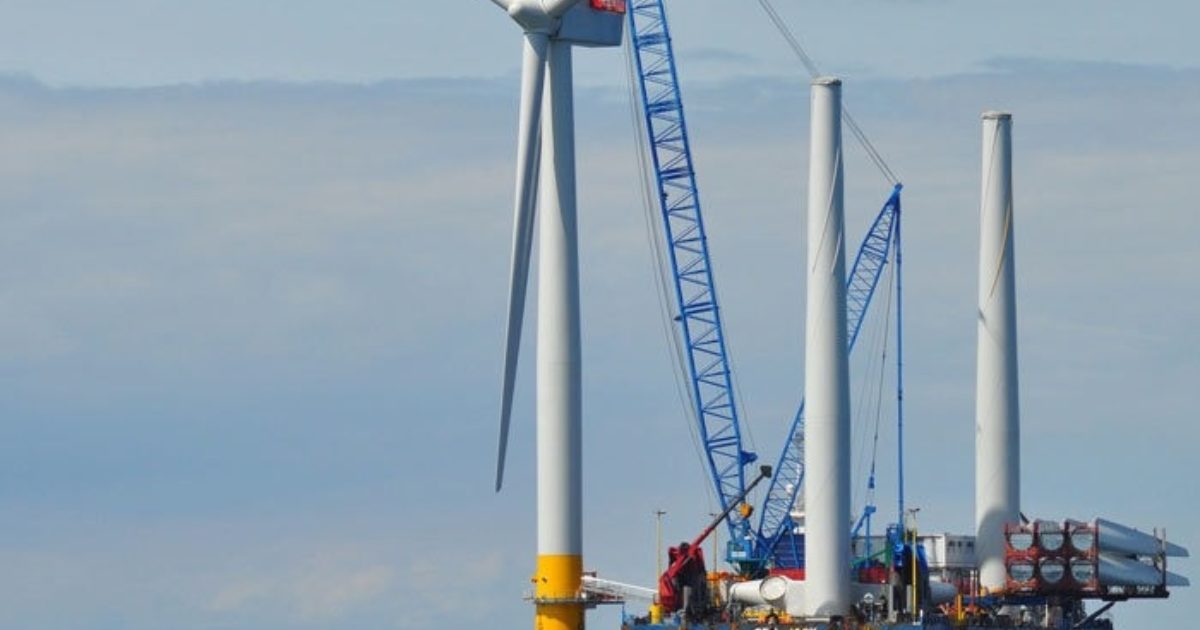New analysis from the Energy and Climate Intelligence Unit (ECIU) has quantified the savings to electricity costs that wind power is delivering by offering lower day-ahead wholesale prices, which could roughly equal the support that wind farms receive from bills. [1]
Wind power is increasingly edging the more expensive gas power plants (that require gas as fuel each time they turn on) off the system, and is helping to reduce the amount of time that gas power stations set the overall price of electricity on the wholesale market. Previous analysis had found gas setting the price of electricity almost 100% of the time, [2] but this now appears to have fallen to around 85% of the time, back in the range from before the pandemic and gas crisis.
The new analysis found wind power reduced the wholesale price of electricity by up to a quarter (25%) in 2024, equivalent to around £25/MWh. This ‘hidden saving’ is the result of wind power diluting the link between power prices and gas prices, which are determined by volatile international markets and have a disproportionate impact on overall electricity costs due to marginal pricing on day-ahead markets.
Dr Simon Cran-McGreehin, Head of Analysis at the Energy and Climate Intelligence Unit (ECIU), said: “Energy experts have long known that the invisible hand of the market would see renewables with no fuel costs reduce the overall cost of electricity by pushing gas power out of the market, and this was starkly highlighted in the gas crisis.
“People may not realise it, but their bills today would be higher today without the increasing role that wind and solar farms running on free sunshine and wind are playing by reducing our dependence on gas power. This also means things could have been even worse during the peaks of the gas crisis, had it not been for renewables – indeed, anything that avoids gas generation helps to limit prices, including interconnectors and our old nuclear power plants.
“Prices can spike when wind is low and gas power plants come on, but this is more than made up for by the overall savings on prices that wind farms deliver the rest of the time.
“Years of underinvestment in our grid means significant upgrades are now needed as demand for electricity increases, but this will deliver more British renewables and so reduce household vulnerability to gas markets whose price is set internationally.”
This estimated saving on wholesale prices due to large-scale wind farms amounts to about £24–25/MWh. Without the reduction due to wind power, the average day-ahead price of £73–76/MWh in 2024 could have been as high as £96–101/MWh.
Links between day-ahead markets and longer-term trades, where the rest of supply is traded, mean that savings of a similar size are likely to be seen for all supply.
The savings translate into about £27–28/MWh in retail prices. If there are similar cuts in prices across all trades, then the savings on bills due to all wind power could roughly match the £27/MWh of support paid on bills to support wind farms via the RO and CfDs.
Given renewables are already suppressing the wholesale price of electricity, this puts a different perspective on strike prices under the Contracts for Difference scheme through which the Government procures new large-scale wind and solar projects. Were it not for existing renewables displacing gas power plants, the wholesale price would be higher than the strike prices for solar and onshore wind, and close to that of offshore wind.
Adam Bell, Director of Policy at Stonehaven, said: “This is immensely valuable work that showcases the extent to which we’d all be paying more if we hadn’t built out our wind fleet over the last twenty years. Pushing older inefficient gas plants out of the market is how wind holds down costs.”
The analysis considered how average prices over a year would have changed if there had been fewer (or no) large wind farms connected to the transmission networks, and instead other parts of the existing generation fleet operated more often. Whilst it might be argued that other assets such as new gas power plants might well have been built instead, the high costs new gas generation would likely have limited its impact on power prices, especially during the gas crisis. Government estimates of the levelised cost of electricity (LCOE), suggest that new gas power plants built now would be more expensive than new renewables, even accounting for higher prices for wind power in recent CfD auctions. [3]
The results are relevant for the wider debate on the clean power transition, presenting a ‘hidden saving’ that can be considered alongside the costs associated with renewables. Future analysis could consider the net effects, and how these are likely to evolve as some costs fall in the near future and the savings on marginal prices grow as more renewables are deployed.
ENDS
Notes to editors:
The report is Marginal Gains: how wind is pushing gas out of the power market and cutting costsWorking Paper #1: The Role of Natural Gas in Electricity Prices in Europe (UCL, 2022, updated 2023): https://www.ucl.ac.uk/bartlett/sites/bartlett/files/the_role_of_natural_gas_in_electricity_prices_in_europe_updated_may_2023.pdfEnergy Generation Cost Projections (DECC/DESNZ, dated various years): https://www.gov.uk/government/collections/energy-generation-cost-projections
For more information or for interview requests:
George Smeeton, Head of Communications, ECIU, Tel: 07894 571 153, email: george.smeeton@eciu.net

